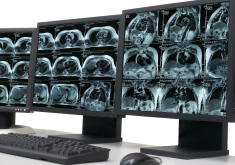La prevalencia e impacto de la medicina defensiva en la evaluación radiográfica del paciente de trauma

1. K. Davis, K. Stremikis, C. Schoen, et al. Mirror, Mirror on the Wall, 2014 Update: How the U.S. Health Care System Compares Internationally. The Commonwealth Fund, New York (2014)
2. National Health Expenditure Projections 2012-2022 Forecast Summary. Available at: http://www.cms.gov/Research-Statistics-Data-and-Systems/Statistics-Trends-and-Reports/NationalHealthExpendData/downloads/proj2012.pdf. Accessed December 24, 2014.
3. PricewaterhouseCoopers’ Health Research Institute. The Price of Excess: Identifying Waste in Healthcare Spending. PricewaterhouseCoopers LLP, Cambridge, MA (2008)
4. D.M. Studdert, M.M. Mello, W.M. Sage, et al. Defensive medicine among high-risk specialist physicians in a volatile malpractice environment. JAMA, 293 (2005), pp. 2609–2617
5. K.E. Kocher, W.J. Meurer, R. Fazel, et al. National trends in use of computed tomography in the emergency department. Ann Emerg Med, 58 (2011), pp. 452–462.e3
6. D.J. Brenner, E.J. Hall. Computed tomography—an increasing source of radiation exposure. N Engl J Med, 357 (2007), pp. 2277–2284
7. B.V. Nahed, M.A. Babu, T.R. Smith, et al. Malpractice liability and defensive medicine: a national survey of neurosurgeons. PLoS One, 7 (2012), p. e39237
8. V. Sathiyakumar, A.A. Jahangir, H.R. Mir, et al. The prevalence and costs of defensive medicine among orthopaedic trauma surgeons: a national survey study. J Orthop Trauma, 27 (2013), pp. 592–597
9. R. Pfeifer, H.C. Pape. Missed injuries in trauma patients: a literature review. Patient Saf Surg, 2 (2008), p. 20
10. B. Sanchez, K. Waxman, T. Jones, et al. Cervical spine clearance in blunt trauma: evaluation of a computed tomography-based protocol. J Trauma, 59 (2005), pp. 179–183
11. D.S. Gill, B. Mitra, F. Reeves, et al. Can initial clinical assessment exclude thoracolumbar vertebral injury? Emerg Med J, 30 (2013), pp. 679–682
12. J. Holmes, E. Panacek, P. Miller, et al. Prospective evaluation of criteria for obtaining thoracolumbar radiographs in trauma patient. J Emerg Med, 24 (2003), pp. 1–7
13. N. Fox, D. Schwartz, J.H. Salazar, et al. Evaluation and management of blunt traumatic aortic injury: a practice management guideline from the Eastern Association for the Surgery of Trauma. J Trauma Acute Care Surg, 78 (2015), pp. 136–146
14. G.G. Wisbach, M.J. Sise, D.I. Sack, et al. What is the role of chest X-ray in the initial assessment of stable trauma patients? J Trauma, 62 (2007), pp. 74–79
15. R.M. Rodriguez, D. Anglin, M.I. Langdorf, et al. NEXUS chest: validation of a decision instrument for selective chest imaging in blunt trauma. JAMA Surg, 148 (2013), pp. 940–946
16. C.C. Burlew, W.L. Biffl, E.E. Moore, et al. Blunt cerebrovascular injuries: redefining screening criteria in the era of noninvasive diagnosis. J Trauma Acute Care Surg, 72 (2012), pp. 330–335 discussion, 336–7, quiz 539
17. A.M. Beliaev, P.A. Barber, R.J. Marshall, et al. Denver screening protocol for blunt cerebrovascular injury reduces the use of multi-detector computed tomography angiography. ANZ J Surg, 84 (2014), pp. 429–432
18. Personal Healthcare Expenditures (PHE) years 1960-2010. Centers for Medicare & Medicaid Services, Office of the Actuary, National Health Statistics Group and U.S. Department of Commerce, Bureau of Economic Analysis. Available at: http://www.cms.gov/Research-Statistics-Data-and-Systems/Statistics-Trends-and-Reports/NationalHealthExpendData/Downloads/tables.pdf. Accessed December 24, 2014.
19. D.U. Himmelstein, D. Thorne, E. Warren, et al. Medical bankruptcy in the United States, 2007: results of a national study Am J Med, 122 (2009), pp. 741–746
20. Institute of Medicine. The Healthcare Imperative: Lowering Costs and Improving Outcomes: Workshop Series Summary. The National Academies Press, Washington, DC (2010)
21. The Centers for Medicare & Medicaid Services (CMS) released the average value of hospital billed charges and their corresponding Medicare reimbursed rates for the 100 most common diagnosis related groups (DRGs): Available at: http://www.hhs.gov/news/press/2013pres/05/20130508a.html. Accessed June 30, 2014.
22. Q2 2011 healthcare transparency index. change: healthcare customer database (12 months of medical, dental and Rx claims for 82,000 employees representing 152,00 lives in all 50 states). Available at: www.changehealthcare.com. Accessed December 24, 2014.
23. National Council on Radiation Protection and Measurements. Ionizing Radiation Exposure of the Population of the United States. National Council on Radiation Protection and Measurements. National Council on Radiation Protection report no. 160, Bethesda, MD (2009)
24. P.K. Nguyen, J.C. Wu. Radiation exposure from imaging tests: is there an increased cancer risk? Expert Rev Cardiovasc Ther, 9 (2011), pp. 177–183
25. D.J. Brenner, R. Doll, D.T. Goodhead, et al. Cancer risks attributable to low doses of ionizing radiation: assessing what we really know. Proc Natl Acad Sci U S A, 100 (2003), pp. 13761–13766
26. A. Berrington de González, S. Darby Risk of cancer from diagnostic X-rays: estimates for the UK and 14 other countries. Lancet, 363 (2004), pp. 345–351
Comentarios
Para ver los comentarios de sus colegas o para expresar su opinión debe ingresar con su cuenta de IntraMed.









